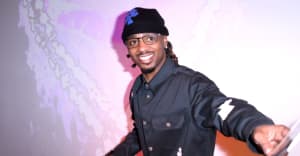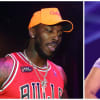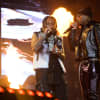Instagram by Brooklyn Wheeler
The line for the Future show at the Shrine, a 600-person-capacity venue in Chicago, wrapped around the block. Doors were set to open for the much-ballyhooed rapper's free performance at 10PM, but some fans had been waiting outside since as early as 9:30 in the morning, according to Fake Shore Drive owner Andrew Barber. (Never underestimate the appeal of the free show in Chicago.) Future's last trip to the region had been a bad experience: a performance at the Markham, Illinois venue Adrianna's in March of this year was marred by a shooting in the parking lot, where a local artist, Chris Smokes, was tragically killed. This show, however, in Chicago's South Loop, was peaceful, a triumphant and competent performance in one of Future's friendliest markets.
The Shrine is a classier nightclub than Future may be used to playing in Chicago: a large poster of Fela Kuti is pinned to a wall at stage left, the drinks steeper in price. The audience was easily 90 percent African American. Local rap celebrities awaiting the rapper's appearance included Vic Mensa (who covered Future's "Codeine Crazy" at the Pitchfork Music Festival just a few days earlier), "The Hills" producer Million $ Mano, street rapper Giftz, and lyrical favorite YP.
Before the show, Power 92 DJ Pharris' crew took off on the turntables, spinning a set that epitomized the sound of Chicago-area rap radio over the past five or six years. With a heavy dose of Southern classics (Boyz N Da Hood's "Bite Down"), local smashes (Lil Herb's "I'm Rollin," Chief Keef's "Faneto"), and an inordinate number of Gucci Mane deep cuts dating back to the late 2000s (easily more than ten songs), the DJ set provides context for both the rise of drill three years ago and the prominence of Future today. Atlanta and Chicago remain closely connected cities: their sounds are not identical, and which Southern records take off in the city can seem arbitrary. Yet for a metropolis whose people migrated from the South just a few generations earlier, Chicago's street rap shares more commonalities with Atlanta than either New York or Los Angeles. In this, Chicago is a connector: the country's third-largest city, it's historically one of Atlanta's largest consumer markets.
Instagram by Brooklyn Wheeler
Not long after midnight, Future took the stage, kicking off with highlights from his prolific string of recent tapes—56 Nights’ "Never Gon Lose" and Monster's "My Savages," plus "Real Sisters," an especially ecstatic recitation of "March Madness," and "Trap Niggaz." The crowd responded to each by shouting his lyrics back to him. Soon, he was joined onstage by at least 20 others, a clique he claimed represented the city's East Side. The room vibrated with energy, although often through a glaze of cool detachment and inebriated restraint. It was unlike, say, the unadulterated energy seen at 2 Chainz's performance at the Metro three years earlier. Although 2 Chainz had once been Atlanta's chosen son, on this night, his music seems to have disappeared from the DJ's repertoires, suggesting Future's catalog is more embedded in Chicago, and allows for a deeper dive.
But it was DS2, Future’s strong new album released just last week, that occupied the bulk of his set. He performed it nearly front to back, from “Blow a Bag” and "Thought It Was a Drought" through "I Serve the Base," "Groupies" to "Stick Talk" to Tru remake "Freak Hoes," up through the set-closer "Fuck Up Some Commas." There were few surprises, but it was cathartic all the same. Sometimes he'd cut tracks off after just the chorus; others he'd go one to two verses deep, seldom indulging in any record's full expanse for more than a minute or two. "We ain't doing none of that pop shit," he said at one point, emphasizing his latest record's comeback narrative. “This album for us.” And though the night's highlight may well have been "March Madness" from 56 Nights, it was clear the audience was already well versed in his latest. He shouted out Metro Boomin for executive producing DS2, and he limited his motions onstage to jumping along with the beat, letting the audience's familiarity with the songs lift him up.
Future may seem like an unlikely star in 2015: despite the strides he's made to enhance and magnify his artistic vision—by deepening the narratives that have always underlined his work—he's in some ways still a classic introvert. Yet it's hard to envision a rapper more apt to be heard in Chicago's streets these days. Although his relationship with the press has withered and regrown over the last several years, his core audience has stuck closely by him. He may not quite match the dominance Gucci held in 2009, but Future is the closest since, crafting indelible anthems that appeal despite his lack of a home-field advantage—and with a new generation nipping at his heels.
There are two more free shows in Future's "Salute the Fans" tour: New York tonight, and L.A. tomorrow.


